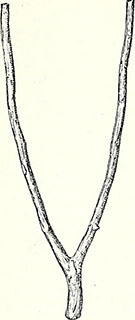Witch Hazel : Mystical Powers
|
“Superstitious folk gave the witch hazel plant its name in awe of supposed powers of a plant that blooms late in autumn...” (Fulling, 1953, p. 362). The believed magical powers of Hamamelis virginiana can be traced by looking at the etymology of its common name, witch hazel. “Witch” may be derived from the old English world “wice”, which means “to bend”, or “wich” which, similarly, means “weak”, as in pliant. These terms describe the suppleness of witch hazel’s branches and twigs: they were used by Native Americans for tools, like bows, and also dowsing rods. H. virginiana’s common name was given by the colonists because it reminded them of their native elm Ulmus glabra, the “witch hazel tree”, which was also used for dowsing and tools in Europe. Upon seeing the Native Americans using the tree in a similar fashion, they thought their elm’s powers had manifested in this new plant. The idea of pliancy derived from the word “witch” refers to witch hazel’s ability to bend and be used as a tool and also that it would bend at sources of power. “The ‘divining rod’ or ‘wishing rod’ or ‘finding stick’ is a Y-shaped section of a branch, with all its leaves removed. It must be new wood and it must have grown upon the tree in such a position that the rising and setting sun looked between the prongs” (Fulling, 1953, p. 370). Witch hazel became the preferred wood for dowsing rods, which were used in the occult arts and also to find hidden water supplies and also mineral deposits. Extracts made from the twigs of the tree, when ingested, were also believed to “infuse the imbiber with occult powers” (Coladonato, 1993). Both the uses and common name of Hamamelis virginiana are representative of its believed historical powers. Though dowsing and occult practices are not as common today, they do provide a background for the development of the plant’s other uses.
|
|


